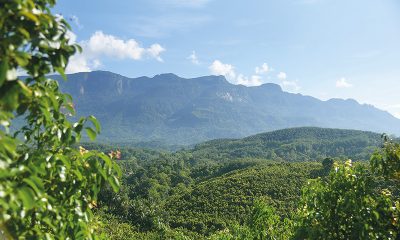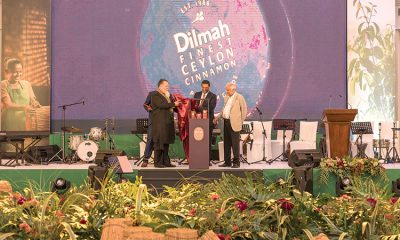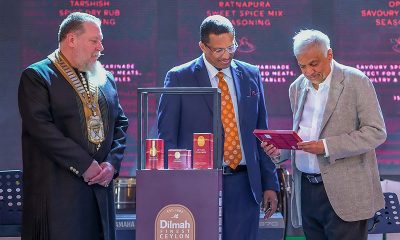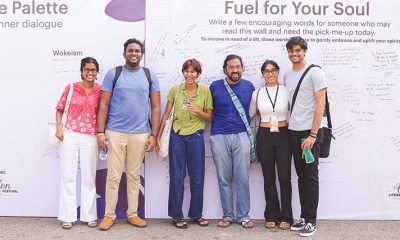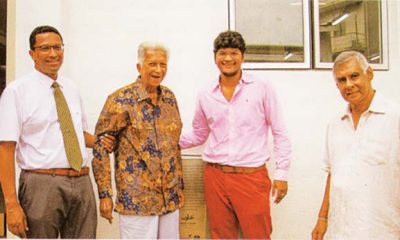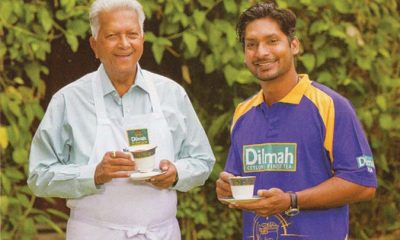Features
STRUGGLING WITH THE TEA BOARD
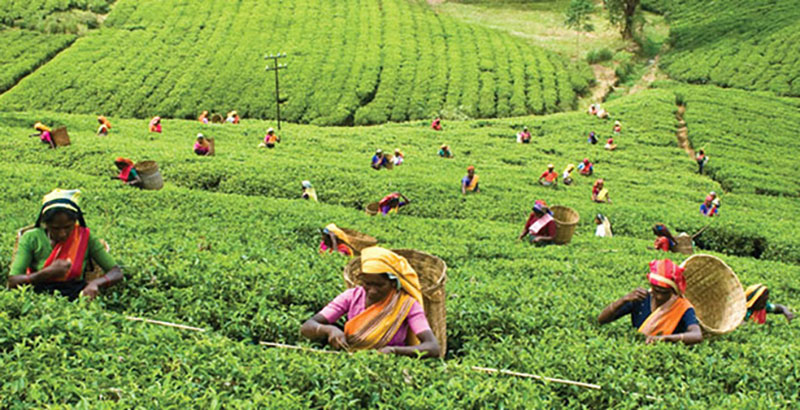
(Excerpted from the autobiography of Merrill J. Fernando)
My fervent appeals to the Tea Board for assistance to local brand builders to develop own brands were, as I said earlier, supported -V Victor Santiapillai. My strategy proposal to launch ‘Dilmah’ in Australia as a fully Sri Lankan-owned tea brand was the first such initiative presented to the Tea Board. The Board was enthusiastic and voted the funds I solicited – approximately Australian Dollars 300,000 (Rs. 5.9 million then). However, the Secretariat bureaucracy, without consulting me, submitted a paper proposing that my project, and all future projects, should be funded on 50/50 basis, between the Board and the exporter. This was, actually, a great blow to my plans, as a tea bagging project is an enormously costly exercise, requiring extensive investment in plant and machinery.
The opposition to my project from the Secretariat is demonstrated by one single fact; the Dilmah initiative went before the Funding Committee – consisting of Government nominees of the Board – no less than 21 times, before it was approved! The many projects which were approved at a single sitting disappeared from view within a short space of time. The Dilmah project, approved so grudgingly by this Funding Committee, is the only such initiative still in successful operation.
Finally, following comprehensive clarifications on brand building and launching expenditure submitted by me to the Tea Board, supported by Santiapillai, as I have mentioned earlier in this chapter, it was agreed that such costs would be shared on an equal basis by the EDB, Tea Board, and Dilmah. Despite the delayed approval, my project continued to be plagued by the tardiness and active opposition by key members of the Secretariat.
The Tea Board share of the promotional costs was unduly delayed, causing me and my distributor in Australia serious embarrassment. Dr. Wickrema Weerasooriya, then High Commissioner for Sri Lanka in Australia, had to intervene several times on my behalf with the Chairman of the SLTB, though his appeals were stifled by the Secretariat. At no stage in these painful exercises did I appeal for assistance to the Plantations Minister, Major Jayawickrema, who had ceased to be my father-in-law 12 years previously.
Today, Dilmah carries the message of Pure Ceylon Tea to over 100 countries worldwide. Had I succumbed to the animosity generated against the Dilmah project at the outset, today there would not be one locally-owned label, selling successfully in overseas markets dominated by multinationals. As opposed to that, over the decades the Tea Board has invested millions of dollars, fruitlessly, in a multiplicity of tea promotional projects, but Dilmah remains the only success story, proving beyond doubt that my company was the right partner then for the EDB/SLTB project, to represent Pure Ceylon Tea in an overseas market.
MORE CONFLICT
One of the main reasons for my numerous conflicts with the long-established trade bodies was their general resistance to change and to my insistence on a more proactive approach from those bodies. The industry in Sri Lanka, on account of its vulnerability to both internal and external dynamics consumption patterns, international financial upheavals, regional conflicts and many more is a highly-volatile system. Our trade governance and regulatory bodies seemed to be entrenched in an archaic mindset, with a singular inability, or reluctance, to offer proactive responses to predictable market disruptions. The tendency seemed to be to jealously guard the status quo.
Once, in a move to change the entrenched ‘clubbiness’ of the CTTA, we enabled the election of Lofty Wijeratne, then a Director of Carsons, as Chairman. Despite requests from many members of the trade, I steadfastly refused to consider the position myself. Lofty, too, was subject to many pressures from vested interests within. I recall a request he made to me, obviously due to compulsion from established brokers, not to support Ajit Chitty’s application for a tea broker’s license. I disagreed and persisted in my support of Ajit, as I was of the firm view that the trade should encourage the emergence of more local companies. Finally, Ajit entered the broking fraternity with Eastern Brokers and made a very good thing of it.
I am also aware that during this period, when I was involved with numerous issues impacting on the interests of the local exporter, CTTA representatives had been instructed by the relevant British masters to oppose any and all of my initiatives and proposals.
In the many years of its existence, the CTTA has, on the whole, done a reasonable job in protecting and fostering industry interests. However, my view is that the constant pressures brought on it by a wide spectrum of industry-related parties and entities has, in recent decades, prevented it from a strict and objective pursuit of its mandate. When the British dominated every aspect of the tea industry, there was no dissent or conflict of interest, as there was tacit agreement that the CTTA and every other trade-related body was committed to the protection of British interests.
The Chamber of Commerce too was not free of this type of internal manipulation and inbuilt politicking. One year I was appointed to the committee of the Chamber. At my very first meeting, a very senior member with strong interests in banking brought in a related issue which was not on the agenda. My objection to the discussion of this item, on those very grounds, was accepted and the matter was dropped immediately.
- Minister Colvin’s observations on Multi-National exploitation of our tea
- My battle with the Tea Hub cabal headlined in newsprint “an unfinished struggle”
Within two weeks, Suneetha Jayawickreme, who was then Secretary of the Chamber, called me to advise that a regulation of the Chamber precluded two individuals from the same group of companies from serving on the committee simultaneously. He pointed out that Jayasingham of Harrisons & Crossfield and I were both on the Harrisons Travel Services Board, and that in compliance with the Chamber stipulation, I should resign. I immediately did so, without even waiting for a written confirmation of the discussion. I was actually amused that interested parties had used a legitimate convention, though the association was tenuous, to ease out an individual who was, obviously, not prepared to toe the general line.
I must also state that the criticisms I have levelled against all these boards is in connection with their administration and trajectories as of the early 1970s and across the ’80s. That era is now history, though the consequences of both inaction and misdirected strategies of that time were long-term impediments to the development of the country’s tea export trade. The thinking within those entities is far more balanced and enlightened now, the Tea Exporter’s Association excluded, for reasons which I will explain in a subsequent chapter.
AN ATTEMPTED RECONCILIATION
When a group of traders decided that their parochial interests should supersede industry welfare in its totality, and sought to launch the Tea Exporters’ Association (TEA), I believe that all traders, without exception, supported the move. Several senior members invited me to join but I refused, giving them very good reasons for my opposition to it. One of the members was the late Michael de Zoysa, then Managing Director of Lipton and for many years a prime mover in the CTTA. He and I frequently disagreed with each other on a number of important trade-related issues. After his retirement from Lipton also he approached me on several occasions and tried to persuade me to join the TEA, on the grounds that the trade was now thinking differently and that they would like to consider my views seriously and work together for common goals.
At first I refused to engage in any discussion on the matter but, finally, after several personal approaches by Michael, I agreed to meet a six-member team of trade representatives led by him. During his years at Lipton, our frequently-conflicting views on common trade-related issues had led to a certain frostiness in our relationship, although we had known each other for years.
I appreciated that as a senior manager of a multinational trader, which he had joined straight from school, he was obliged to guard its interests which, however, were generally inconsistent with those of the local exporter of a locally-owned brand. Things between us changed substantially after his retirement, though, and our relationship became more relaxed, particularly because, once freed from the professional obligation of serving the narrow interests of a multinational, he was able to take a more objective and liberal view of the trade.
Fate, however, does not respect human motives or human plans. Tragically, Michael died suddenly and, instead of chairing the meeting that was scheduled to be held at my home on 30th September 2019, I attended his funeral on that day. Along with Michael, the possibility of a reunification of divergent tea trade interests was also laid to rest. Despite our differences, we treated each other with respect, as we were both men with strong opinions on subjects that were also our passion.
THE TEA HUB A Toxic Proposal
In my view, in no other concept or proposal, is the venality of many of our tea traders and their submissiveness to colonial and multinational domination, as clearly demonstrated, as in the arguments that have been offered in support of the ‘Tea Hub’ hypothesis.
In essence, the Tea Hub concept is an initiative to import cheap Black Tea to Sri Lanka, for blending with our tea and for re-export thereafter. The component of cheap, imported tea in the blend, would reduce the cost of the resulting export and improve the profit margin of the local packer.
This concept has a long history.
THE CLOUD ON THE HORIZON
In 1979, the then Minister of Trade, the late Lalith Athulathmudali, visited the Rotterdam factory of Van Rees, a multinational trader. It was a centre for the bulking, blending, and packaging of cheap tea from multiple auction centres, sold thereafter in the Netherlands and various other European markets. Minister Athulathmudali, ignorant of the background realities of the local trade, had been deeply impressed by the scale of the Van Rees operation and, on his return, strongly advocated the setting up of a similar facility in Sri Lanka. When his views were made public, I vehemently objected to the proposal, giving reasons for my stance.
Athulathmudali was adamant but, fortunately, the then President, J. R. Jayewardene, summoned me, obtained my views, and immediately decided to shelve the idea. To the best of my recollection that was the first public airing of the Tea Hub concept. Since then, from time to time, the proposal has surfaced, on the initiative of traders who believe that selling Ceylon Tea cheap is the way forward.
I also recall that in late 1988, R. M. B. Senanayake, former civil servant and then General Manager of Jafferjee Brothers, in a newspaper article, suggested that whenever Ceylon Tea prices move up, exporters should be permitted to import cheaper tea for blending, in place of Tea. My reaction to it then was consternation, that a man who -lave known better should publicly advocate a policy with such potential for damage to the local tea industry.
NEW DEVELOPMENTS
1st August 2011, the trade members of the Tea Council of the Sri Lanka Tea Board, acting on behalf of the Tea Exporters’ Association
submitted to the Tea Council of which I was then Chairman proposal to lift the existing restrictions on the importation of
Orthodox Black Tea. Whilst as Chairman of the council I did not express my opinion on the matter, I refuted the proposal in my personal
capacity as an exporter and in the larger interests of the tea industry the country.
In the many adverse opinions that were expressed regarding my position on this issue, and of my subsequent vocal and active opposition to the proposal, what was conveniently ignored by all my opponents was :hat liberalisation of Black Tea imports would be greatly advantageous to my own label, ‘Dilmah’. With the global outreach of that brand and the marketing and distribution network which reinforced its overseas sales in over 100 countries, I stood to gain more than any other local exporter by the liberalisation of Black Tea importation.
The provision to import specialty tea, not traditionally manufactured locally, is permitted by statute. If I recall rightly, such importation was first permitted in 1981 and the relevant conditions revised in 1994. The 1981 provision was withdrawn when Monty Jayawickrema, then Minister of Plantations, on a visit to Egypt with a trade delegation, ascertained for himself that exporters had been blending cheap Chinese tea with Ceylon Tea in order to reduce the blend cost and were providing the Egyptian market with a very low quality product, which was being perceived by the consumer as Ceylon Tea. Ironically, that is a perfect example of the proposed methodology of the Tea Hub and, also, its likely outcome.
There is no argument against the limited facilities available to the serious exporter for the importation of specialty tea such Darjeeling, select Assams, or other non-traditional varieties, not normally produced in this country. It is a legitimate and acceptable strategy used by exporters to widen their export product portfolio. Such teas are, invariably, far more costly on an average than Ceylon Tea and the Government permits imports of such varieties without restriction. The annual importation of specialty tea is around five million kg per year, equivalent to 2% of the average annual Black Tea production of Sri Lanka, and is a volume which has no impact on the local industry.
A Tea Hub is of immense attraction to the multinational trader or the local exporter, who packs on his behalf. It will enable the former to source his product at low cost, with zero investment in infrastructure, as that will be provided by his local servant at the latter’s cost. Foreign label owners have no loyalty, either to the country of operation, the operation itself, or even to the consumer. He is motivated entirely by the bottom line and when appropriate, he will move out to another location which is able to serve his needs at a lower cost. This is an inevitable progression and can be illustrated with real-life examples.
FLAWED LOGIC
In their support of the Tea Hub proposal, the TEA submitted a wide range of arguments, all virtuously clothed to project an image of potential advantages to the local tea industry, when the actual intent was simply lowering the cost of their export blend.
One of the major planks of the TEA platform has been the totally unsupported premise, that the Tea Hub would soon result in growing the present annual export value of Ceylon Tea, from USD 1.2 billion to USD 5 billion. This hypothesis was never supported by either strategy, complementing arithmetic, or a financially-verifiable equation, and still remains a pathetic piece of wishful thinking. One of their primary concerns is that the high value of Ceylon Tea is an impediment to the servicing of international markets, and that the local opponents of the concept should not be apprehensive, that importation of cheap tea would devalue equivalent grades at the Colombo Auction.
Such arguments defy the simplest concepts of product supply, demand, and price dynamics, and do not merit an elaborate rebuttal. The Tea Hub proposal is based on plain self-delusion, garnished by unverifiable and statistically-unsupportable assumptions. A favourite theory of many economists and marketing consultants with absolutely no practical knowledge of the local tea industry in its totality is based on the feeble assumption that Sri Lankans are not capable of building brands and, therefore, the best option is to reduce Pure Ceylon Tea to the status of a commodity, or a raw material, for branding and value addition elsewhere.
Annually, we produce around 300 million kg of tea and sell all of it at the Colombo Auction, at the highest average price of any auction centre. On an average, we are generally around USD 1 higher than the second highest auction centre, Nairobi. With their wide-ranging arguments for a Tea Hub, that is the real issue that its proponents wish to address; the relatively high auction price in Colombo. The trader who is exporting a cheap commodity at Rs. 500 – Rs. 600 per kg is unable to compete with the local entrepreneur who is exporting a genuine good quality Ceylon Tea, with value added, at Rs. 1,000 per kg or more.
Even the Tea Hub proponents agree that Pure Ceylon Tea is of the finest quality. It does not require marketing expertise to conclude that a product which justifiably claims to be the best in quality must then be marketed at a commensurate price. That is an argument which any consumer will accept. For instance, there there are markets for both `Plonk’ and for high quality wine, with a massive price differential between the two.
The Unique Selling Point of the former is price, whilst that of the latter is quality, which is where quality Ceylon Tea belongs.
Another argument that the Tea Hub offers is the increase of export volume, through importation and re-export after blending. Judging the effectiveness of an export operation by volume alone is a serious mistake, as it distorts realities. What is relevant is not the volume and foreign exchange earned, but the contribution to actual value. Heavy exports of bulk tea and crudely-presented small packs, meant for cheap markets, bring little or no return to the exporter. Those are simply services provided to the multinational trader, by the local packer, with marginal corresponding benefits to the country of production. Value addition to the home-grown product, in the country of origin, is the only strategy which will ensure that all those in the commercial chain, from the farmer to the exporter, reap equitable benefits.
DISASTROUS CONSEQUENCES
The ruthless philosophy of the multinational packer and retail supplier is to buy low and sell high in mass markets in which the consumer, through relentless advertising and promotion, has been compelled to accept a well-packaged mediocrity masquerading as excellence. The intrinsic value of a product such as Pure Ceylon Tea and its inherent value proposition is subordinated to profit. Concepts such as genuine product purity and uniqueness of origin have no place in such a world. Such values do not belong in the base culture of mass-marketing of bland, homogenous products.
The importation of cheap tea from multiple origins would immediately result in the discounting, at the Colombo Auction, of equivalent grades produced in this country, which would invariably be of a higher value than the import. In fact, the cost of any cheap imported tea would be well below our national cost of production, which, for a number of well known reasons, is the highest in the world.
A glut of such low-priced imported tea would depress auction prices overall and adversely impact the grower and producer, who are already burdened by high production costs and diminishing land and worker productivity. In the meantime, the cheap blend, with its desirability enhanced by the legend ‘packed in Sri Lanka/Ceylon,’ will be perceived as genuine Ceylon Tea by the overseas consumer. That perception will cause irreparable damage to the image of Pure Ceylon Tea and, also, to the exporter of the genuine product.
Despite the many abuses it has been subject to over the years, at the hands of multinationals and other traders, who have no respect for either purity or origins, Ceylon Tea is not a commodity as other teas are. Pure Ceylon Tea, of itself and in itself, is a brand and a specialty in the eyes of the consumer. There is no other tea in the world which is recognised internationally by the country of its origin like Ceylon Tea; nor is any other country globally identified by the tea it produces like Sri Lanka/Ceylon. Up to about 20 years ago, Ceylon Tea was promoted and marketed on that unique value proposition and that memory still lingers in the minds of the older, middle-aged consumer. It was that memory of quality which ensured the success of Dilmah in Australia, despite it being priced well above its competing brands produced by the big multinationals.
Features
The heart-friendly health minister

by Dr Gotabhya Ranasinghe
Senior Consultant Cardiologist
National Hospital Sri Lanka
When we sought a meeting with Hon Dr. Ramesh Pathirana, Minister of Health, he graciously cleared his busy schedule to accommodate us. Renowned for his attentive listening and deep understanding, Minister Pathirana is dedicated to advancing the health sector. His openness and transparency exemplify the qualities of an exemplary politician and minister.
Dr. Palitha Mahipala, the current Health Secretary, demonstrates both commendable enthusiasm and unwavering support. This combination of attributes makes him a highly compatible colleague for the esteemed Minister of Health.
Our discussion centered on a project that has been in the works for the past 30 years, one that no other minister had managed to advance.
Minister Pathirana, however, recognized the project’s significance and its potential to revolutionize care for heart patients.
The project involves the construction of a state-of-the-art facility at the premises of the National Hospital Colombo. The project’s location within the premises of the National Hospital underscores its importance and relevance to the healthcare infrastructure of the nation.
This facility will include a cardiology building and a tertiary care center, equipped with the latest technology to handle and treat all types of heart-related conditions and surgeries.
Securing funding was a major milestone for this initiative. Minister Pathirana successfully obtained approval for a $40 billion loan from the Asian Development Bank. With the funding in place, the foundation stone is scheduled to be laid in September this year, and construction will begin in January 2025.
This project guarantees a consistent and uninterrupted supply of stents and related medications for heart patients. As a result, patients will have timely access to essential medical supplies during their treatment and recovery. By securing these critical resources, the project aims to enhance patient outcomes, minimize treatment delays, and maintain the highest standards of cardiac care.
Upon its fruition, this monumental building will serve as a beacon of hope and healing, symbolizing the unwavering dedication to improving patient outcomes and fostering a healthier society.We anticipate a future marked by significant progress and positive outcomes in Sri Lanka’s cardiovascular treatment landscape within the foreseeable timeframe.
Features
A LOVING TRIBUTE TO JESUIT FR. ALOYSIUS PIERIS ON HIS 90th BIRTHDAY

by Fr. Emmanuel Fernando, OMI
Jesuit Fr. Aloysius Pieris (affectionately called Fr. Aloy) celebrated his 90th birthday on April 9, 2024 and I, as the editor of our Oblate Journal, THE MISSIONARY OBLATE had gone to press by that time. Immediately I decided to publish an article, appreciating the untiring selfless services he continues to offer for inter-Faith dialogue, the renewal of the Catholic Church, his concern for the poor and the suffering Sri Lankan masses and to me, the present writer.
It was in 1988, when I was appointed Director of the Oblate Scholastics at Ampitiya by the then Oblate Provincial Fr. Anselm Silva, that I came to know Fr. Aloy more closely. Knowing well his expertise in matters spiritual, theological, Indological and pastoral, and with the collaborative spirit of my companion-formators, our Oblate Scholastics were sent to Tulana, the Research and Encounter Centre, Kelaniya, of which he is the Founder-Director, for ‘exposure-programmes’ on matters spiritual, biblical, theological and pastoral. Some of these dimensions according to my view and that of my companion-formators, were not available at the National Seminary, Ampitiya.
Ever since that time, our Oblate formators/ accompaniers at the Oblate Scholasticate, Ampitiya , have continued to send our Oblate Scholastics to Tulana Centre for deepening their insights and convictions regarding matters needed to serve the people in today’s context. Fr. Aloy also had tried very enthusiastically with the Oblate team headed by Frs. Oswald Firth and Clement Waidyasekara to begin a Theologate, directed by the Religious Congregations in Sri Lanka, for the contextual formation/ accompaniment of their members. It should very well be a desired goal of the Leaders / Provincials of the Religious Congregations.
Besides being a formator/accompanier at the Oblate Scholasticate, I was entrusted also with the task of editing and publishing our Oblate journal, ‘The Missionary Oblate’. To maintain the quality of the journal I continue to depend on Fr. Aloy for his thought-provoking and stimulating articles on Biblical Spirituality, Biblical Theology and Ecclesiology. I am very grateful to him for his generous assistance. Of late, his writings on renewal of the Church, initiated by Pope St. John XX111 and continued by Pope Francis through the Synodal path, published in our Oblate journal, enable our readers to focus their attention also on the needed renewal in the Catholic Church in Sri Lanka. Fr. Aloy appreciated very much the Synodal path adopted by the Jesuit Pope Francis for the renewal of the Church, rooted very much on prayerful discernment. In my Religious and presbyteral life, Fr.Aloy continues to be my spiritual animator / guide and ongoing formator / acccompanier.
Fr. Aloysius Pieris, BA Hons (Lond), LPh (SHC, India), STL (PFT, Naples), PhD (SLU/VC), ThD (Tilburg), D.Ltt (KU), has been one of the eminent Asian theologians well recognized internationally and one who has lectured and held visiting chairs in many universities both in the West and in the East. Many members of Religious Congregations from Asian countries have benefited from his lectures and guidance in the East Asian Pastoral Institute (EAPI) in Manila, Philippines. He had been a Theologian consulted by the Federation of Asian Bishops’ Conferences for many years. During his professorship at the Gregorian University in Rome, he was called to be a member of a special group of advisers on other religions consulted by Pope Paul VI.
Fr. Aloy is the author of more than 30 books and well over 500 Research Papers. Some of his books and articles have been translated and published in several countries. Among those books, one can find the following: 1) The Genesis of an Asian Theology of Liberation (An Autobiographical Excursus on the Art of Theologising in Asia, 2) An Asian Theology of Liberation, 3) Providential Timeliness of Vatican 11 (a long-overdue halt to a scandalous millennium, 4) Give Vatican 11 a chance, 5) Leadership in the Church, 6) Relishing our faith in working for justice (Themes for study and discussion), 7) A Message meant mainly, not exclusively for Jesuits (Background information necessary for helping Francis renew the Church), 8) Lent in Lanka (Reflections and Resolutions, 9) Love meets wisdom (A Christian Experience of Buddhism, 10) Fire and Water 11) God’s Reign for God’s poor, 12) Our Unhiddden Agenda (How we Jesuits work, pray and form our men). He is also the Editor of two journals, Vagdevi, Journal of Religious Reflection and Dialogue, New Series.
Fr. Aloy has a BA in Pali and Sanskrit from the University of London and a Ph.D in Buddhist Philosophy from the University of Sri Lankan, Vidyodaya Campus. On Nov. 23, 2019, he was awarded the prestigious honorary Doctorate of Literature (D.Litt) by the Chancellor of the University of Kelaniya, the Most Venerable Welamitiyawe Dharmakirthi Sri Kusala Dhamma Thera.
Fr. Aloy continues to be a promoter of Gospel values and virtues. Justice as a constitutive dimension of love and social concern for the downtrodden masses are very much noted in his life and work. He had very much appreciated the commitment of the late Fr. Joseph (Joe) Fernando, the National Director of the Social and Economic Centre (SEDEC) for the poor.
In Sri Lanka, a few religious Congregations – the Good Shepherd Sisters, the Christian Brothers, the Marist Brothers and the Oblates – have invited him to animate their members especially during their Provincial Congresses, Chapters and International Conferences. The mainline Christian Churches also have sought his advice and followed his seminars. I, for one, regret very much, that the Sri Lankan authorities of the Catholic Church –today’s Hierarchy—- have not sought Fr.
Aloy’s expertise for the renewal of the Catholic Church in Sri Lanka and thus have not benefited from the immense store of wisdom and insight that he can offer to our local Church while the Sri Lankan bishops who governed the Catholic church in the immediate aftermath of the Second Vatican Council (Edmund Fernando OMI, Anthony de Saram, Leo Nanayakkara OSB, Frank Marcus Fernando, Paul Perera,) visited him and consulted him on many matters. Among the Tamil Bishops, Bishop Rayappu Joseph was keeping close contact with him and Bishop J. Deogupillai hosted him and his team visiting him after the horrible Black July massacre of Tamils.
Features
A fairy tale, success or debacle

Sri Lanka-Singapore Free Trade Agreement
By Gomi Senadhira
senadhiragomi@gmail.com
“You might tell fairy tales, but the progress of a country cannot be achieved through such narratives. A country cannot be developed by making false promises. The country moved backward because of the electoral promises made by political parties throughout time. We have witnessed that the ultimate result of this is the country becoming bankrupt. Unfortunately, many segments of the population have not come to realize this yet.” – President Ranil Wickremesinghe, 2024 Budget speech
Any Sri Lankan would agree with the above words of President Wickremesinghe on the false promises our politicians and officials make and the fairy tales they narrate which bankrupted this country. So, to understand this, let’s look at one such fairy tale with lots of false promises; Ranil Wickremesinghe’s greatest achievement in the area of international trade and investment promotion during the Yahapalana period, Sri Lanka-Singapore Free Trade Agreement (SLSFTA).
It is appropriate and timely to do it now as Finance Minister Wickremesinghe has just presented to parliament a bill on the National Policy on Economic Transformation which includes the establishment of an Office for International Trade and the Sri Lanka Institute of Economics and International Trade.
Was SLSFTA a “Cleverly negotiated Free Trade Agreement” as stated by the (former) Minister of Development Strategies and International Trade Malik Samarawickrama during the Parliamentary Debate on the SLSFTA in July 2018, or a colossal blunder covered up with lies, false promises, and fairy tales? After SLSFTA was signed there were a number of fairy tales published on this agreement by the Ministry of Development Strategies and International, Institute of Policy Studies, and others.
However, for this article, I would like to limit my comments to the speech by Minister Samarawickrama during the Parliamentary Debate, and the two most important areas in the agreement which were covered up with lies, fairy tales, and false promises, namely: revenue loss for Sri Lanka and Investment from Singapore. On the other important area, “Waste products dumping” I do not want to comment here as I have written extensively on the issue.
1. The revenue loss
During the Parliamentary Debate in July 2018, Minister Samarawickrama stated “…. let me reiterate that this FTA with Singapore has been very cleverly negotiated by us…. The liberalisation programme under this FTA has been carefully designed to have the least impact on domestic industry and revenue collection. We have included all revenue sensitive items in the negative list of items which will not be subject to removal of tariff. Therefore, 97.8% revenue from Customs duty is protected. Our tariff liberalisation will take place over a period of 12-15 years! In fact, the revenue earned through tariffs on goods imported from Singapore last year was Rs. 35 billion.
The revenue loss for over the next 15 years due to the FTA is only Rs. 733 million– which when annualised, on average, is just Rs. 51 million. That is just 0.14% per year! So anyone who claims the Singapore FTA causes revenue loss to the Government cannot do basic arithmetic! Mr. Speaker, in conclusion, I call on my fellow members of this House – don’t mislead the public with baseless criticism that is not grounded in facts. Don’t look at petty politics and use these issues for your own political survival.”
I was surprised to read the minister’s speech because an article published in January 2018 in “The Straits Times“, based on information released by the Singaporean Negotiators stated, “…. With the FTA, tariff savings for Singapore exports are estimated to hit $10 million annually“.
As the annual tariff savings (that is the revenue loss for Sri Lanka) calculated by the Singaporean Negotiators, Singaporean $ 10 million (Sri Lankan rupees 1,200 million in 2018) was way above the rupees’ 733 million revenue loss for 15 years estimated by the Sri Lankan negotiators, it was clear to any observer that one of the parties to the agreement had not done the basic arithmetic!
Six years later, according to a report published by “The Morning” newspaper, speaking at the Committee on Public Finance (COPF) on 7th May 2024, Mr Samarawickrama’s chief trade negotiator K.J. Weerasinghehad had admitted “…. that forecasted revenue loss for the Government of Sri Lanka through the Singapore FTA is Rs. 450 million in 2023 and Rs. 1.3 billion in 2024.”
If these numbers are correct, as tariff liberalisation under the SLSFTA has just started, we will pass Rs 2 billion very soon. Then, the question is how Sri Lanka’s trade negotiators made such a colossal blunder. Didn’t they do their basic arithmetic? If they didn’t know how to do basic arithmetic they should have at least done their basic readings. For example, the headline of the article published in The Straits Times in January 2018 was “Singapore, Sri Lanka sign FTA, annual savings of $10m expected”.
Anyway, as Sri Lanka’s chief negotiator reiterated at the COPF meeting that “…. since 99% of the tariffs in Singapore have zero rates of duty, Sri Lanka has agreed on 80% tariff liberalisation over a period of 15 years while expecting Singapore investments to address the imbalance in trade,” let’s turn towards investment.
Investment from Singapore
In July 2018, speaking during the Parliamentary Debate on the FTA this is what Minister Malik Samarawickrama stated on investment from Singapore, “Already, thanks to this FTA, in just the past two-and-a-half months since the agreement came into effect we have received a proposal from Singapore for investment amounting to $ 14.8 billion in an oil refinery for export of petroleum products. In addition, we have proposals for a steel manufacturing plant for exports ($ 1 billion investment), flour milling plant ($ 50 million), sugar refinery ($ 200 million). This adds up to more than $ 16.05 billion in the pipeline on these projects alone.
And all of these projects will create thousands of more jobs for our people. In principle approval has already been granted by the BOI and the investors are awaiting the release of land the environmental approvals to commence the project.
I request the Opposition and those with vested interests to change their narrow-minded thinking and join us to develop our country. We must always look at what is best for the whole community, not just the few who may oppose. We owe it to our people to courageously take decisions that will change their lives for the better.”
According to the media report I quoted earlier, speaking at the Committee on Public Finance (COPF) Chief Negotiator Weerasinghe has admitted that Sri Lanka was not happy with overall Singapore investments that have come in the past few years in return for the trade liberalisation under the Singapore-Sri Lanka Free Trade Agreement. He has added that between 2021 and 2023 the total investment from Singapore had been around $162 million!
What happened to those projects worth $16 billion negotiated, thanks to the SLSFTA, in just the two-and-a-half months after the agreement came into effect and approved by the BOI? I do not know about the steel manufacturing plant for exports ($ 1 billion investment), flour milling plant ($ 50 million) and sugar refinery ($ 200 million).
However, story of the multibillion-dollar investment in the Petroleum Refinery unfolded in a manner that would qualify it as the best fairy tale with false promises presented by our politicians and the officials, prior to 2019 elections.
Though many Sri Lankans got to know, through the media which repeatedly highlighted a plethora of issues surrounding the project and the questionable credentials of the Singaporean investor, the construction work on the Mirrijiwela Oil Refinery along with the cement factory began on the24th of March 2019 with a bang and Minister Ranil Wickremesinghe and his ministers along with the foreign and local dignitaries laid the foundation stones.
That was few months before the 2019 Presidential elections. Inaugurating the construction work Prime Minister Ranil Wickremesinghe said the projects will create thousands of job opportunities in the area and surrounding districts.
The oil refinery, which was to be built over 200 acres of land, with the capacity to refine 200,000 barrels of crude oil per day, was to generate US$7 billion of exports and create 1,500 direct and 3,000 indirect jobs. The construction of the refinery was to be completed in 44 months. Four years later, in August 2023 the Cabinet of Ministers approved the proposal presented by President Ranil Wickremesinghe to cancel the agreement with the investors of the refinery as the project has not been implemented! Can they explain to the country how much money was wasted to produce that fairy tale?
It is obvious that the President, ministers, and officials had made huge blunders and had deliberately misled the public and the parliament on the revenue loss and potential investment from SLSFTA with fairy tales and false promises.
As the president himself said, a country cannot be developed by making false promises or with fairy tales and these false promises and fairy tales had bankrupted the country. “Unfortunately, many segments of the population have not come to realize this yet”.
(The writer, a specialist and an activist on trade and development issues . )





